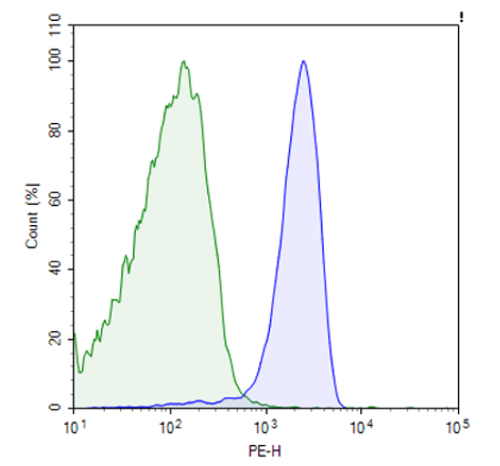78535
TGFBR2 CRISPR/Cas9 Lentivirus (Integrating)
BPS Bioscience
DESCRIPTION
Transforming growth factor receptor beta 2 (TGFBR2) encodes the TGF-β receptor protein, which is a transmembrane protein that forms a heterodimeric complex with other receptor proteins and binds TGF-β. This receptor/ligand complex phosphorylates proteins which regulate cell proliferation, cell cycle arrest, wound healing, and immunosuppression. Mutations in TGFBR2 have been linked with Marfan syndrome and the development of various types of tumors.
The TGFBR2 CRISPR/Cas9 Lentiviruses are replication incompetent, HIV-based VSV-G pseudo-typed lentiviral particles ready to infect most types of mammalian cells, including primary and non-dividing cells. The particles contain a CRISPR/Cas9 gene driven by an EF1a promoter, along with 5 sgRNA (single guide RNA) targeting human TGFBR2.
The DNA transduced by this lentivirus integrates randomly into the cellular genome to express both Cas9 and sgRNA. Puromycin selection increases the knockout efficiency by forcing high expression levels of both Cas9 and the sgRNA, and can be used with the integrating lentivirus to quickly and easily achieve high knockdown efficiencies in a cell pool. Knockdown efficiency is dependent on cell type.
DETAILS
- Notes: The CRISPR/CAS9 technology is covered under numerous patents, including U.S. Patent Nos. 8,697,359 and 8,771,945, as well as corresponding foreign patents applications, and patent rights. Biosafety: The lentiviruses are produced with the SIN (self-inactivation) lentivector which ensures self-inactivation of the lentiviral construct after transduction and after integration into the genomic DNA of the target cells. None of the HIV genes (gag, pol, rev) will be expressed in the transduced cells, as they are expressed from packaging plasmids lacking the packing signal and are not present in the lentivirus particle. Although the pseudotyped lentiviruses are replication-incompetent, they require the use of a Biosafety Level 2 facility. BPS Bioscience recommends following all local federal, state, and institutional regulations and using all appropriate safety precautions. Troubleshooting Guide: Visit bpsbioscience.com/lentivirus-faq for detailed troubleshooting instructions. For all further questions, please email support@bpsbioscience.com.
- Shiptemp: -80°C (dry ice)
- Warnings: Avoid freeze/thaw cycles.
- Category: Cell Signaling/Lentivirus
- Description: Transforming growth factor receptor beta 2 (TGFBR2) encodes the TGF-β receptor protein, which is a transmembrane protein that forms a heterodimeric complex with other receptor proteins and binds TGF-β. This receptor/ligand complex phosphorylates proteins which regulate cell proliferation, cell cycle arrest, wound healing, and immunosuppression. Mutations in TGFBR2 have been linked with Marfan syndrome and the development of various types of tumors. The TGFBR2 CRISPR/Cas9 Lentiviruses are replication incompetent, HIV-based VSV-G pseudo-typed lentiviral particles ready to infect most types of mammalian cells, including primary and non-dividing cells. The particles contain a CRISPR/Cas9 gene driven by an EF1a promoter, along with 5 sgRNA (single guide RNA) targeting human TGFBR2. The DNA transduced by this lentivirus integrates randomly into the cellular genome to express both Cas9 and sgRNA. Puromycin selection increases the knockout efficiency by forcing high expression levels of both Cas9 and the sgRNA, and can be used with the integrating lentivirus to quickly and easily achieve high knockdown efficiencies in a cell pool. Knockdown efficiency is dependent on cell type.
- Formulation: The lentivirus particles were produced from HEK293T cells. They are supplied in cell culture medium containing 90% DMEM + 10% FBS.
- Supplied As: Two vials (500 µl x 2) of lentivirus at a titer ≥1 x 107 TU/ml. The titer will vary with each lot; the exact value is provided with each shipment.
- Unspsc Code: 41106621
- Unspsc Name: Virus mediated expression vectors or kits
- Applications: Transient knockdown of TGFBR2 in target cells Generation of a stable TGFBR2 knockout cell line following puromycin selection and limiting dilution
- Product Type: Lentivirus
- Biosafety Level: BSL-2
- Related Products: 78061, 78054, 78065, 78058
- Storage Stability: Lentiviruses are shipped with dry ice. For long term storage, it is recommended to store the virus at -80°C. Avoid repeated freeze-thaw cycles. Titers can drop significantly with each freeze-thaw cycle.
- Scientific Category: Cell Signaling Pathway
